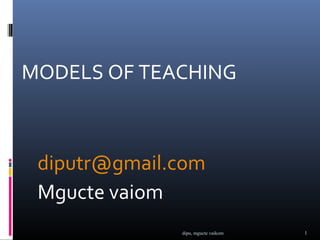
Models of teaching
- 1. MODELS OF TEACHING diputr@gmail.com Mgucte vaiom dipu, mgucte vaikom 1
- 2. A model of teaching is a pattern or plan which can be taken up with a view to shape a curriculum or course, select appropriate instructional material and to guide the teacher’s action dipu, mgucte vaikom 2
- 3. DEFINITION BRUCE JOYCE AND MARSHA WEIL “Teaching models are just instructional designs . They describe the process of specifying and producing particular environmental situations which cause the student interact in such a way that specific changes occur in his behavior” dipu, mgucte vaikom 3
- 4. Role of teaching models It may help the teacher to develop his capacity to teach larger number of children and create conducive environment for their learning. It may help the curriculum makers to plan learning centered curriculum which provides a variety of educational experiences to children. It may help to create more interesting and effective instructional material and learning sources. It may stimulate the development of new and better forms and opportunities for education, that will replaces schools of today. dipu, mgucte vaikom 4
- 5. Families of teaching models The information processing family The personal family The social family The behavioral system family dipu, mgucte vaikom 5
- 6. 1. The information processing family This family focus on intellectual capacity The primary purpose are Mastering of the method of enquiry Developing the skill for processing information Fostering the ability to think logically dipu, mgucte vaikom 6
- 7. 1. The Information processing family 1. Concept Attainment Model - Jerome S Bruner 2. Inductive thinking Model - Hilda Taba 3. Inquiry training Model - J. Richard Suchman 4. Advance Organizer Model - David ausubel 5. memory model - Jerry Lucas 6. Biological Science Inquiry Model- Joseph Schwab 7. Cognitive development model -Jean Piaget, Kohlberg, Siegal dipu, mgucte vaikom 7
- 8. 2. The personal family This deals with the personal development of the individual The primary goals are To increase the students sense of self worth To help students understand themselves more fully To help students refine their their emotions To foster the students creativity dipu, mgucte vaikom 8
- 9. 2. The personal family 1. Non-directive teaching model -Carl Rogers 2. Synetics model -William J. J. gordon 3. Awareness training model -William Schutz and George Brown 4. Class room teaching model -William Glasser dipu, mgucte vaikom 9
- 10. 3. The social family This family emphasis the relationship of the individual to society To train work together to develop students skills for maintaining human relations To inculcate personal and social values dipu, mgucte vaikom 10
- 11. 3. The social family 1. Group investigation model -Herbert Thelen 2. Role playing model -Fannie & Gerorge Shaftel 3. Jurisprudential inquiry model -Donald oliver 4. Laboratory training model -National training laboratory 5. Social simulation model -cyberneticcs psychologists 6. Social inquiry model -Thelen, Oliver, Sharer dipu, mgucte vaikom 11
- 12. 4. The behavioral system family It emphasis on changing the observable behaviour of the learner The specific goals are To develop competency to adopt behevior styles appropriate to given situations To learn strategies for self control through oparant methods To master techniques for stress reduction To foster leadership quality dipu, mgucte vaikom 12
- 13. 4. The behavioral system family 1. Contingency management model -B. F. skinner 2. Self control through operant methods -B. F. Skinner 3. Stress reduction model -Joseph Wolpe 4. Desensitisation model -Rimm & Master 5. Assertive training model -Wolpe & Lazarus dipu, mgucte vaikom 13
- 14. Key concepts for describing teaching models Four major components are included in all teaching models. Each of these components will vary with the models. The four major components are 1. Syntax 2. Social system 3. Principles of reaction 4. Support system dipu, mgucte vaikom 14
- 15. 1. Syntax This is description of how the various phases in the development of a lesson are sequenced when the model is translated in to action. The phases involved in the different models will differ. dipu, mgucte vaikom 15
- 16. For Example, In Concept attainment In the inquiry training model model Lesson may begin by Beginning will be the exhibiting an example with indication of the presentation of a problematic attributes to be situation that calls for observed. Hypothesing by the pupil. Prsented by them in the form Presentation of situations leading to of questions, resulting in the discrimination, rejection or acceptance of a classification, hypothesis. generalization, definition-in short, concept attainment dipu, mgucte vaikom 16
- 17. 2. Social system The relation ship between the teacher and the learners as well as the role played by each in the activities that take place define the nature of social system. dipu, mgucte vaikom 17
- 18. Highly structured. The activities of the pupil will more controlled by external restrictions with a pre determined structuring. Low structured the teacher withdraws to the maximum possible and free interaction among the learners. Moderately structured the nature of lesson depends upon the roles, relationships, norms and the nature of activities of teacher and the learner. dipu, mgucte vaikom 18
- 19. 3. Principles of reaction [rules to be followed] This defines the nature of reaction expected from the teacher to every pupil activity. The principles of reaction give guidance to the teacher as to how he is expected to react to each activity of the learners, to suit the characteristics of the model selected. dipu, mgucte vaikom 19
- 20. 4. Support system Every model of teaching warrants certain conditions and facilities for the realization of the goal. A description of this support system ion advance will help the teacher ensure that he can apply the model successfully. dipu, mgucte vaikom 20
- 21. f. Instructional and Nurturant effect Direct / instructional effect of a lesson as purposefully envisaged by the teacher. Indirect / nurturant effects that might happen as a byproduct. dipu, mgucte vaikom 21
